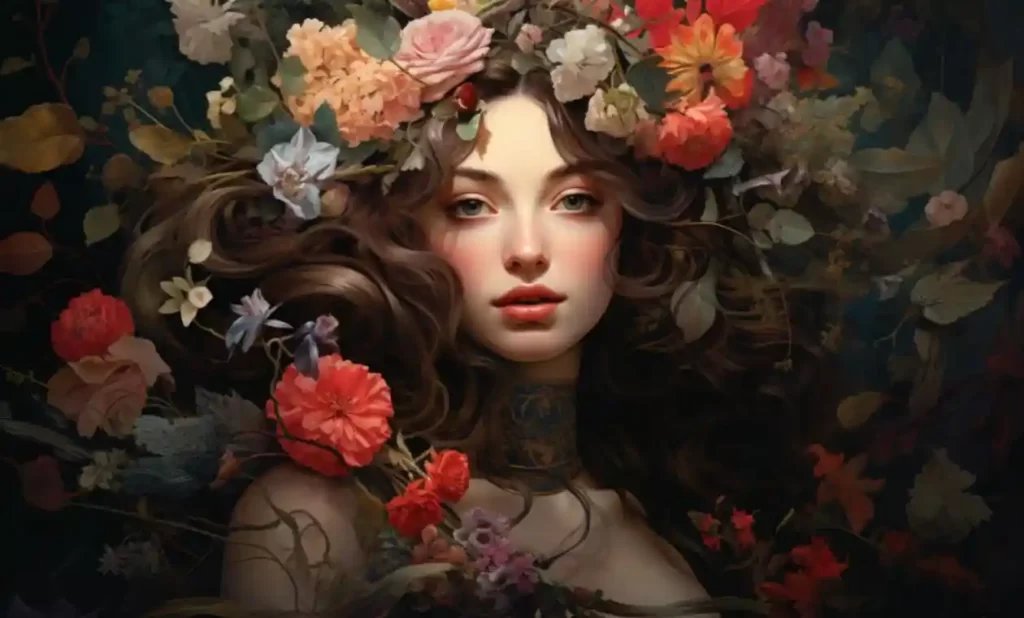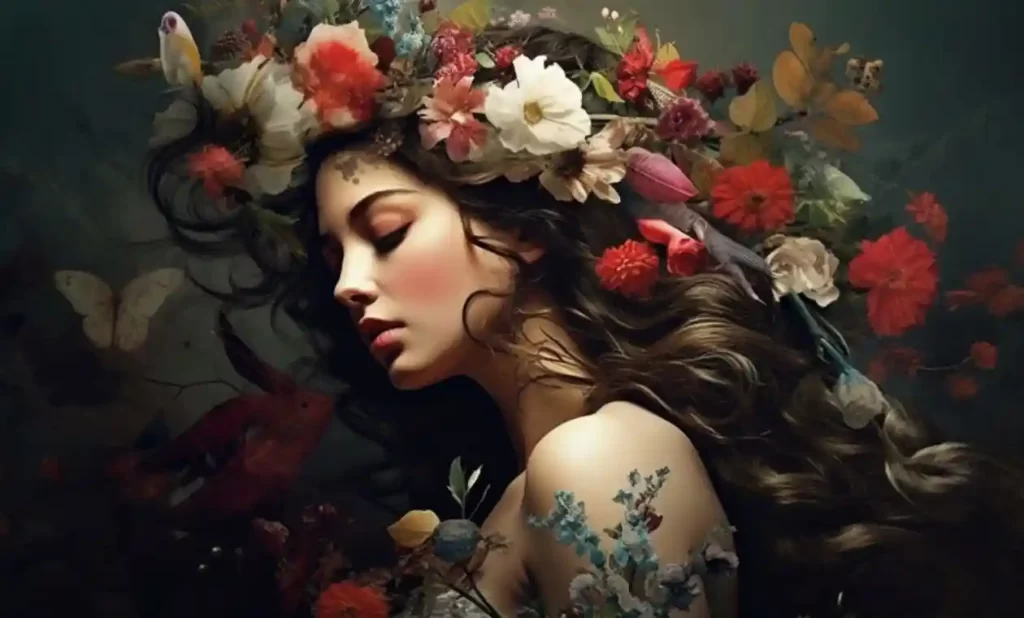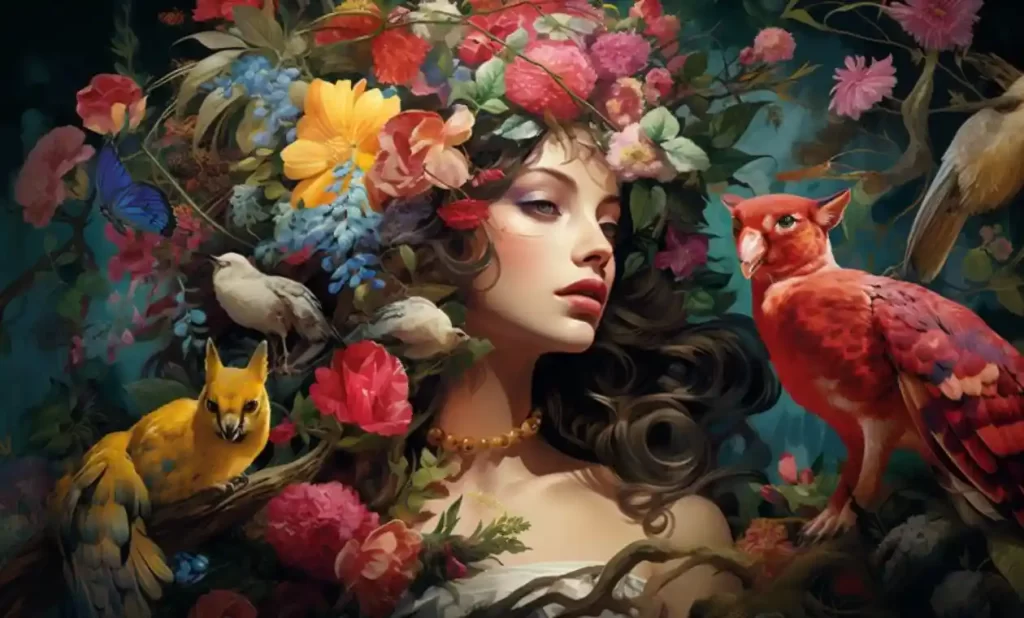
In the realm of ancient tales and beliefs, mythology weaves a captivating tapestry that has enraptured civilizations through the ages. These myths, often born from the mysteries of nature and the human experience, offer glimpses into the profound connections between mortals and the divine. Among the pantheon of deities that graced the hearts of the Romans, one figure stands as a resplendent embodiment of nature’s beauty and the magic of renewal – Flora, the goddess of flowers and springtime.
From the verdant valleys to the towering peaks, the landscapes of the ancient world whispered secrets of the divine through the rustle of leaves and the blooming of petals. Nature itself seemed to house celestial beings, personifications of the earth’s bounties and phenomena. In this rich tapestry of myth and reverence, Flora emerges as a symbol of the cycle of life, the enchantment of rebirth, and the jubilation of spring’s embrace.
Who is Flora in Roman Mythology? Blossoming Beauty Amidst the Gods
In the tapestry of Roman mythology, where gods and goddesses held sway over the realms of mortals and nature, Flora emerged as a luminous figure embodying the very essence of spring’s awakening. She was not merely a distant deity but a living representation of the vibrant world that unfolded each year as winter’s grasp loosened.
Flora’s role was that of a guardian of nature’s splendor, a curator of colors and fragrances that adorned the landscapes. As winter’s chill gave way to the gentle touch of spring, Flora’s presence could be felt in every bud that unfurled and every blossom that graced the land. She held the delicate power to transform barren fields into a tapestry of life, painting meadows with a palette of hues that celebrated life’s resilience.
The heart of Flora’s identity lay in her personification of the very essence of spring – the time of renewal and growth. As the world reawakened from its slumber, Flora’s touch could be seen in the delicate petals that kissed the sun’s warmth and the fragrant blossoms that breathed life into the air. Her divinity was intertwined with the rhythm of the seasons, a rhythm that danced to the tune of nature’s symphony.
Beyond the picturesque landscapes, Flora held a vital connection to the sustenance of the Roman people. She was hailed as a patroness of agriculture, revered for her influence on the fertility of crops. Her benevolence was sought by farmers and cultivators, who recognized her role in the cycle of planting, growth, and harvest. With each flourishing field, Flora’s grace was evident, reminding all of the intricate balance between humanity and the earth.
In the whispers of the wind and the laughter of blooming flowers, the Romans found solace in Flora’s presence. She was not just a goddess but a guardian of life’s resplendence, a reminder that even in the harshest of winters, the promise of spring’s embrace awaited. As we venture deeper into Flora’s realm, we uncover the symbols and stories that encapsulate her essence and the celebrations that honored her legacy.
Significance of Flora in Roman Culture: Nurturer of Crops and Keeper of Joy

In the bustling streets and quiet corners of ancient Rome, Flora’s influence reverberated through the hearts of its people, shaping not only their beliefs but also the rhythms of their lives. She was not merely a distant deity, but a cherished presence whose benevolence touched every aspect of Roman culture.
Within the realms of Roman religious practices, Flora held a place of honor that resonated deeply with the community. Her divine presence was invoked during rituals and ceremonies, where offerings of flowers and fragrant herbs were tenderly presented. These offerings symbolized the people’s gratitude for her role in orchestrating the symphony of spring’s return and ensuring the bounty of the fields.
Flora’s significance extended beyond the realm of devotion, intertwining with the very essence of Roman life. As the patroness of agriculture, she was revered by those who toiled in the fields, their livelihoods entwined with the fertile soil she nurtured. Farmers looked to her for blessings, beseeching her to bless their crops with abundant growth and protect them from the vagaries of nature. With each seed planted, the people’s faith in Flora’s influence deepened, forging a connection that transcended mere superstition.
The Romans believed that Flora’s touch extended beyond the physical realm, shaping the very seasons themselves. She was thought to hold the key to the changing of seasons, orchestrating the transition from the cold grasp of winter to the warm embrace of spring. This belief underscored her role as a bringer of hope, a harbinger of renewal that resonated in the hearts of those who longed for the return of life’s vibrant colors after the gray shroud of winter.
As the Roman people reveled in the joy of festivals and the pleasures of life, they recognized Flora’s hand in the tapestry of their existence. The Floralia, a grand festival dedicated to her, was celebrated with exuberant merriment. During this time, the streets adorned with flowers and garlands transformed into a realm of revelry, where dancing, singing, and theatrical performances celebrated the very spirit of Flora herself.
Through the layers of time and the stories passed down, Flora emerges not just as a goddess but as a symbol of resilience, a guardian of the eternal cycle of life and the embodiment of the joy that nature brings. As we immerse ourselves further, we unravel the symbols that encapsulate her essence and the myths that carry her legacy forward.
Symbols Associated with Flora: Nature’s Blossoming Embrace
In the realm of myth and reverence, symbols serve as a bridge between the mortal world and the divine. These emblems, woven with meaning and magic, offer glimpses into the essence of deities such as Flora – the Roman goddess of flowers and springtime. Through symbols both simple and profound, Flora’s presence was invoked and celebrated, breathing life into rituals and ceremonies.
Foremost among the symbols that adorned Flora’s divine aura were the flowers and plants that bloomed under her watchful eye. Each petal, each leaf, was a testament to her nurturing touch. The delicate petals of roses, the regal presence of lilies, and the vibrant hues of daffodils – all whispered stories of Flora’s benevolence. These symbols of nature’s beauty were cherished not only for their aesthetic allure but also for the deeper connection they held with the goddess herself.
Wreaths, woven from flowers and leaves, held a special significance in Flora’s realm. These circular garlands, crafted with care and devotion, were more than mere ornaments – they were tokens of reverence that connected mortals to the divine. Wreaths adorned with her favorite blooms were offered during ceremonies and festivals dedicated to Flora. As the delicate fragrance wafted through the air, it was believed that these wreaths carried the prayers and hopes of the people, bridging the gap between earth and sky.
Rituals dedicated to Flora often incorporated these symbols in ways that celebrated the changing seasons and sought her blessings. During the Floralia festival, for instance, participants donned wreaths of flowers as they indulged in joyous revelry. The streets were adorned with floral garlands, transforming the cityscape into a living tapestry of colors that mirrored the vibrant spirit of Flora herself.
These symbols weren’t just passive ornaments; they were living tributes that breathed life into Flora’s legacy. In the act of adorning wreaths, in the artistry of arranging petals, the people expressed their gratitude for her touch in every blooming blossom and swaying stem. The symbols that adorned Flora’s name held stories of renewal, resilience, and the profound connection between humanity and nature.
Worship and Festivals: A Tapestry of Devotion to Flora
In the heart of ancient Rome, where myths intermingled with daily life, the reverence for deities found expression through worship and vibrant celebrations. Flora, the goddess of flowers and springtime, was not only a figure of admiration but a source of devotion that resonated through rituals and festivals, binding the community in a tapestry of shared faith.
The worship of Flora in ancient Rome was a testament to the profound connection between humanity and the natural world. Temples dedicated to her were places of solace and prayer, where offerings of flowers, garlands, and fragrant herbs were tenderly presented. These offerings were more than mere gifts; they were tokens of gratitude for the beauty that Flora bestowed upon the earth and the promise of renewal she carried within her embrace.
Amidst the myriad festivals that painted the Roman calendar, the Floralia stood as a radiant celebration dedicated to Flora’s essence. This lively festival, held from April 28 to May 3, marked the transition from the chill of winter to the exuberance of spring. The Floralia was not just a commemoration but a jubilant expression of Flora’s role as the harbinger of blossoming landscapes and renewed spirits.
During the Floralia, the streets of Rome transformed into a riot of colors and merriment. Symbolic of Flora’s blessings, people donned vibrant clothing and adorned themselves with garlands woven from flowers. The air itself seemed to dance with the fragrant breath of blossoms, infusing the city with a vivacious energy that mirrored Flora’s vibrant spirit.
Dancing and revelry were at the heart of the Floralia, with performances that celebrated life’s vitality and the joy that spring brought. Theatrical productions, music, and games filled the atmosphere with laughter and camaraderie. It was as if the entire city joined in the chorus of nature, celebrating the return of warmth and life after the hushed dormancy of winter.
As the Roman people danced and laughed amidst the splendor of the Floralia, they not only celebrated the goddess but also the very essence of spring. The festival marked the culmination of a season’s anticipation, a moment when the buds unfurled and the flowers blossomed in response to Flora’s touch. The Floralia wasn’t merely a commemoration; it was a communion with nature itself, a testament to the magic that Flora wove into the fabric of the world.
With petals adorning hair and wreaths framing smiles, the Romans embodied Flora’s essence during the Floralia. Through dances, laughter, and shared experiences, they celebrated the goddess who transformed the world into a canvas of colors. As we delve further into the tapestry of Flora’s myths and stories, we’ll uncover her role in the changing of seasons and the poetic narratives that whispered her name through the ages.
Myths and Stories Involving Flora: The Blossoming of Legends

In the realm of myths and legends, Flora’s presence was not confined to rituals and festivals; her essence found life in tales that unfolded like petals under the sun. One such story whispers of her origins and the magical interplay between gods and goddesses, offering a glimpse into the enchantment that surrounded her very being.
Among the gods and goddesses who ruled the pantheon, Vertumnus held a special place. He was the deity of seasons and transformations, his realm echoing the intricate dance of nature’s changes. It was in the embrace of Vertumnus that Flora’s story unfolded, a story that spoke of destiny and the tapestry of connections that wove through the divine realm.
The story goes that Flora, before becoming the radiant goddess we know, was a mortal maiden named Chloris. She wandered through fields and forests, her heart stirred by the beauty that bloomed around her. One day, while strolling through a meadow, Chloris caught the eye of Vertumnus. Enchanted by her grace and captivated by her spirit, Vertumnus fell in love.
Determined to win Chloris’s heart, Vertumnus decided to reveal his true identity. He transformed himself into a variety of forms, each one a reflection of the changing seasons – a harvester, a fisherman, a reaper. With each transformation, he attempted to impress Chloris with his skills and stories.
It was during one of these transformations, as the god of spring, that Vertumnus finally won Chloris’s affections. As they wandered through the blooming landscapes, Vertumnus revealed his true form, basking in Chloris’s love and admiration. Touched by his sincerity and the magic of his transformations, Chloris’s heart opened to him, and their love blossomed like the flowers around them.
As a symbol of their union, Chloris was transformed into Flora – the goddess of flowers and springtime. With her touch, the landscapes flourished, and the earth burst forth in vibrant colors and fragrances. Every flower that graced the world was a testament to the love that had bloomed between Vertumnus and Flora, a love that mirrored the eternal dance between the changing seasons.
In this tale, Flora’s journey from mortal to goddess was a celebration of love, transformation, and the ever-changing beauty of the natural world. Through her interactions with Vertumnus, she not only found her place among the deities but also played a pivotal role in the creation of the diverse and enchanting flora that adorned the earth.
Flora’s Role in Changing Seasons: Weaving the Threads of Renewal
In the ancient tapestry of beliefs, the changing of seasons was a rhythm that echoed with both wonder and mystery. The transition from winter’s chill to spring’s embrace carried an enchantment that transcended the mere passage of time. At the heart of this transformation stood Flora, the goddess of flowers and springtime, her influence intricately woven into the very fabric of nature’s symphony.
The Romans believed that Flora held a celestial thread that connected her to the changing seasons. Just as she nurtured the buds that unfolded into blossoms, she also held sway over the cycle of the seasons – a cycle that mirrored the ebb and flow of life itself. With the passing of winter’s frost, Flora’s touch was believed to awaken the slumbering earth, heralding the arrival of spring.
The Roman belief in Flora’s power to bring forth spring after the cold winter was more than a mere superstition; it was a reflection of their deep connection with the natural world. Just as the delicate petals unfurled in response to her touch, so did the earth awaken from its icy slumber under her guidance. Flora’s influence extended beyond the visible landscapes, reaching into the realm of the unseen, where the balance between life and dormancy was delicately maintained.
The arrival of spring after the hushed whispers of winter was seen as a testament to Flora’s benevolence. Her influence breathed life into the barren landscapes, transforming them into vibrant tapestries of colors and fragrances. The blossoming flowers and the tender leaves unfurling towards the sun were believed to be Flora’s blessings, a gift of renewal that she bestowed upon the world.
This belief in Flora’s role in the changing of seasons mirrored the Roman reverence for the natural world and its cycles. Through her, they found a connection that transcended the mundane, a connection that echoed the mysteries of creation and transformation. With each bloom that graced the earth, with each gentle breeze that carried the fragrance of blossoms, Flora’s presence was affirmed, a living reminder of the divine magic that danced through the seasons.
Artistic Representations of Flora: Nature’s Muse in Roman Art
In the canvas of Roman art and literature, Flora emerged as a figure of ethereal beauty, a muse whose presence was captured through strokes of paint and chiseled stone. As the goddess of flowers and springtime, she inspired artists and writers to create works that celebrated her connection to nature and the enchantment of renewal.
Flora’s depiction in Roman art was a testament to her role as a guardian of nature’s splendor. Artists portrayed her with delicate features and flowing garments that mirrored the grace of the blossoms she oversaw. Her hair was often adorned with floral wreaths, a symbol that connected her to the very essence of her divinity. Each detail, each curve, was meticulously crafted to capture the beauty that Flora personified.
One of the most iconic artistic representations of Flora was in the form of statues and sculptures. These masterpieces, carved from marble and stone, immortalized her essence in three-dimensional form. With a serene expression and a presence that radiated both strength and gentleness, Flora’s sculptures often showcased her in the act of holding flowers or gazing at the blossoms that surrounded her. These sculptures served as a visual tribute to her role as a custodian of nature’s beauty.
Paintings, too, held Flora as a subject of inspiration. Her image graced frescoes and canvases, capturing her in moments of quiet contemplation amidst meadows of flowers or amidst the company of other gods and goddesses. Through these paintings, artists sought to encapsulate not just her physical beauty, but also the enchanting aura that surrounded her – the very essence of spring’s awakening.
Literature, a realm where words danced to form stories and verses, also embraced Flora’s presence. Poets and writers wove tales that spoke of her role in the changing seasons, often employing vivid descriptions that echoed the vibrant landscapes she personified. These words painted mental pictures that allowed readers to glimpse the beauty of Flora’s touch, even in the absence of visual art.
Through the brushstrokes of artists and the ink of writers, Flora’s legacy was woven into the very fabric of Roman culture. She became more than a deity; she became a symbol of nature’s resplendence and the eternal cycle of life’s renewal. With each portrayal that celebrated her essence, artists and writers whispered her name through the ages, inviting us to marvel at the beauty of spring and the magic of Flora’s embrace.
Comparison to Other Nature Deities: Unveiling the Threads of Spring
Across the tapestries of mythologies, nature deities adorned various cultures, each one a unique expression of the enchantment that nature weaves. In the Roman pantheon, Flora stood as the embodiment of flowers and spring, a goddess whose essence resonated with similar figures in other mythologies, such as the Greek goddess Chloris, weaving a tapestry of common themes and nuanced differences.
Flora’s counterpart in Greek mythology was Chloris, a goddess often associated with flowers and springtime. Like Flora, Chloris was revered for her ability to bring forth the vibrant colors and fragrances of blooming flowers. However, while both goddesses shared the domain of nature’s resplendence, their stories and characteristics were shaped by the nuances of their respective cultures.
In Roman mythology, Flora’s tale was interwoven with that of Vertumnus, the deity of seasons. This connection highlighted Flora’s role as the catalyst for the changing of seasons, where her touch breathed life into the world after the slumber of winter. On the other hand, in Greek mythology, Chloris’s story was often intertwined with Zephyrus, the god of the west wind. According to myth, Zephyrus wooed Chloris, and their union resulted in the blossoming of flowers across the earth – a tale that mirrored the delicate dance between wind and bloom.
Both Flora and Chloris represented the magic of spring’s arrival and the beauty of nature’s renewal. They embodied the joy that blossomed after the hushed dormancy of winter, captivating hearts with their ethereal presence. In this common theme, they stood as symbols of hope and the perennial cycles that echoed the rhythms of life itself.
While Flora’s influence extended beyond her connection to spring, Chloris often remained a goddess of flowers exclusively. Flora’s role as a patroness of agriculture and her link to the fertility of crops set her apart, emphasizing her importance in sustaining life beyond the visual beauty of blossoms.
Conclusion: Flora’s Eternal Bloom
In the tapestry of Roman mythology, where gods and goddesses danced amidst the stars and whispered through the leaves, Flora emerged as a luminous figure – a goddess of flowers and springtime whose essence breathed life into every petal and stirred the heart of every mortal. Her significance extended far beyond mere rituals and festivals; she embodied the eternal cycle of nature’s renewal and the magic of spring’s embrace.
Flora’s role as a guardian of nature’s beauty and a patroness of agriculture intertwined her with the very fabric of Roman culture. Through her, the Romans found a connection to the landscapes that surrounded them, an affinity that celebrated the changing seasons and the blessings of bountiful harvests. Her divine touch transformed barren fields into landscapes painted with vibrant colors and fragrant blossoms, reminding all of the intricate dance between humanity and the earth.
With the Floralia festival, Flora’s legacy was celebrated in a riot of colors, dances, and merriment that echoed her spirit. This lively festival marked the return of warmth and life after the cold grasp of winter, offering a tangible communion with the very essence of spring. Through these festivities, Flora’s significance was affirmed as a beacon of hope, a reminder that even in the darkest of times, the promise of renewal and beauty awaited.
Flora’s influence didn’t wane with the passing of time; instead, it continued to inspire our appreciation for nature and the changing seasons. Her stories and symbols whispered tales of resilience, transformation, and the eternal rhythm that underpins life’s cycles. In every blossom that graces our gardens and in the fragrant air that caresses our senses, Flora’s presence endures, inviting us to marvel at the enchantment of spring and the beauty that unfurls with each passing season.
Hey kids, how much did you like Flora – The Enchanting Roman Goddess of Flowers and Spring? Please share your view in the comment box. Also, please share this story with your friends on social media so they can also enjoy it, and for more such Roman Mythology, please bookmark storiespub.com.
Related Article –



